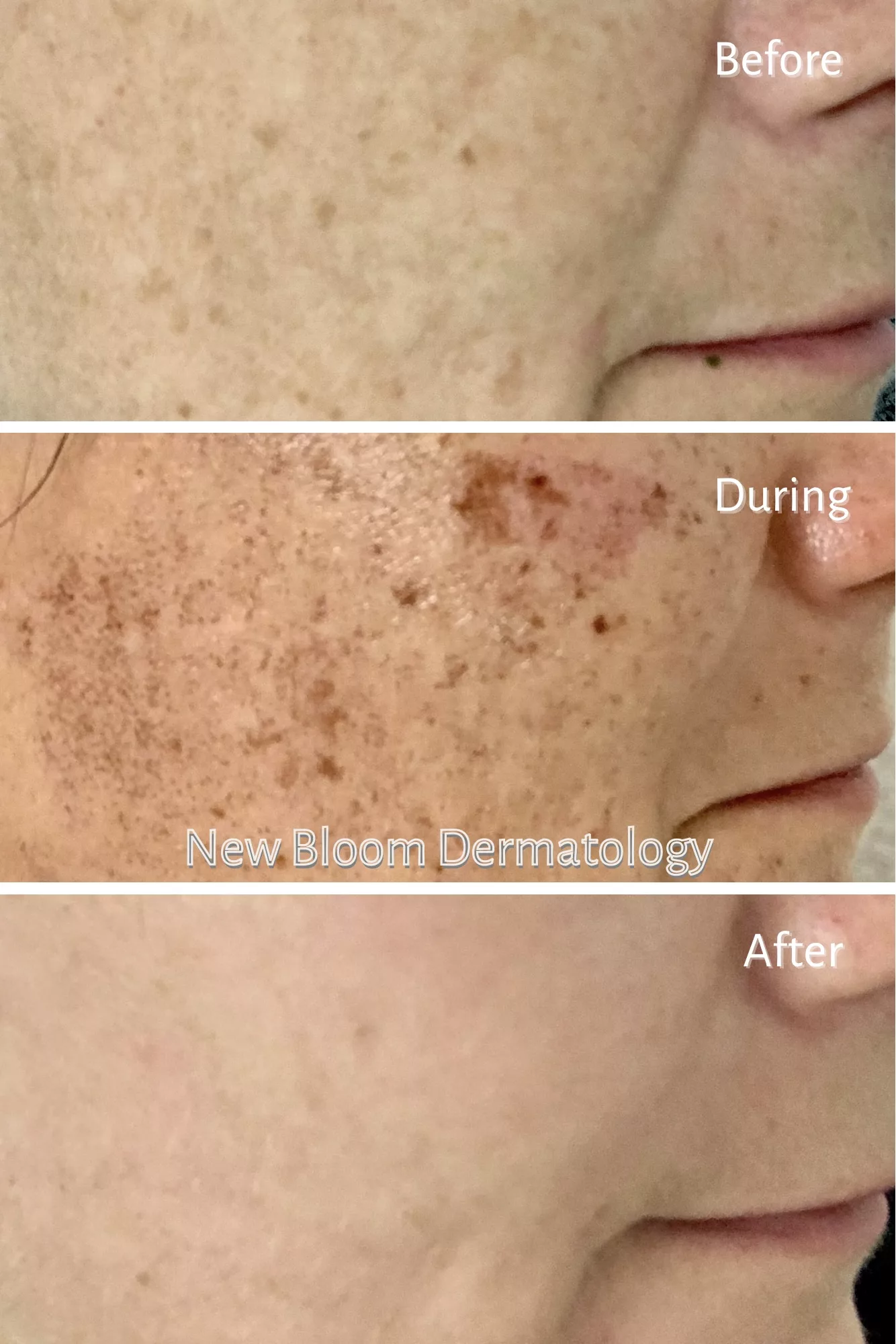Intense Pulsed Light (IPL)
What is Intense Pulsed Light (IPL)?
Also known as photofacial and BroadBand Light™ (BBL™), Intense Pulsed Light (IPL) is composed of lamps and a broad range of wavelengths to target a specific concern. IPL heats the upper layer of the skin with photothermal energy, targeting dark spots and redness while stimulating cell regeneration. This combination helps reduce the signs of aging. IPL is the best treatment for freckles and age spots on the face, arms, hands, and chest.
IPL also can be customized to reduce the appearance of acne and acne scars. The blue light reduces acne bacteria, the yellow light reduces redness and inflammation, and the infra-red light enhances the results of the first two lights.
How does Intense Pulsed Light (IPL) work?

Photos taken before, three days, and ten days after treatment show decreased sun spots and hyperpigmentation.
IPL uses specific wavelengths to target a specific concern. These targets include brown spots, such as solar lentigos, macular seborrheic keratosis, and freckles. Other targets include redness from superficial and deep blood vessels.
The heat generated from photothermal energy stimulates collagen production, which tightens loose skin and improves the skin’s tone and texture.
The wavelengths for IPL can also be used to treat inflammatory acne. The blue light targets bacteria associated with acne. The yellow light targets redness and inflammation.
Who is a candidate for Intense Pulsed Light (IPL)? Who is not a candidate?
Patients who are seeking treatment for age spots and red discoloration as a result of sun damage would benefit from IPL treatment.
Patients with darker skin should avoid treatment, as the treatment can cause blisters, hyperpigmentation, and hypopigmentation. Patients who are pregnant should hold off on treatment. Furthermore, patients who have an active skin infection or taken accutane or isotretinoin within the prior six months are recommended to avoid treatment. Patients with melasma are recommended to seek other treatment options, as IPL may worsen the condition.
How do you prepare for Intense Pulsed Light (IPL)?
Patients are advised to avoid sun exposure one month before and after the procedure, as there is a greater chance of blistering and pigment changes on tanned skin. Patients with a prior history of cold sores would benefit from taking anti-viral medication before and after treatment to prevent outbreaks. Finally, patients are advised to stop topical retinoids five days before the procedure.
What can you expect during Intense Pulsed Light (IPL) treatment?
After the face is cleansed, ultrasound gel is applied and goggles are worn to protect the eyes. The applicator is glided over the treatment area while pulses of light are applied. The pulses feel like heated rubber bands snapping on the skin. After the treatment, ice packs are applied to cool down the skin and sunscreen is applied.
What is the aftercare and recovery for Intense Pulsed Light (IPL) treatment?
Patients experience darkening of pigment, increased redness, and mild swelling to the treatment area. Patients can continue icing the treatment area to reduce the redness and swelling. The dark spots form coffee ground stains and fade or peel while the redness and swelling subside after four days on the face, up to two weeks on the chest. Patients are recommended to keep the treatment area constantly moisturized. After the dark spots peel and the redness subsides, healthy skin is revealed. Patients are advised to avoid the sun for four weeks after treatment to prevent the recurrence of sun spots and redness.
What are the side effects of Intense Pulsed Light (IPL) treatment?
Side effects include redness, swelling, and darkening of pigment. Aggressive settings, especially on tanned skin or darker skin types, can cause blistering, scarring, hyperpigmentation, and hypopigmentation.
When will I notice results from Intense Pulsed Light (IPL) ? How many treatments are needed?
Full results can be seen two four weeks after treatment. Patients are recommended to have at least two treatments performed four weeks apart, ideally during the fall, winter, or early spring months.
What are the potential costs for Intense Pulsed Light (IPL)?
Please contact the office at (212) 207-0078 or info@newbloomderm.com for pricing per session.
How is Intense Pulsed Light (IPL) different from the other treatments offered?
Intense Pulsed Light is a non-invasive treatment that does not require topical numbing. It also does not involve any injections of materials or ablation of the skin. IPL is ideal for patients who are seeking clearance of brown discoloration and redness. Patients who predominantly have blood vessels and red discoloration may benefit from Excel® V Laser. Patients who are seeking to treat both brown discoloration and skin laxity may instead consider Sylfirm X RF microneedling. Darker skin types who are seeking to treat brown and red discoloration from sun damage may consider LaseMD™. Patients with melasma would benefit from treatment with LaseMD™ or Clear + Brilliant® Touch Laser, as there is less risk of recurrence with these treatments.
Before any treatments are scheduled, a cosmetic consultation is required to ensure that Intense Pulsed Light (IPL) is an appropriate treatment.